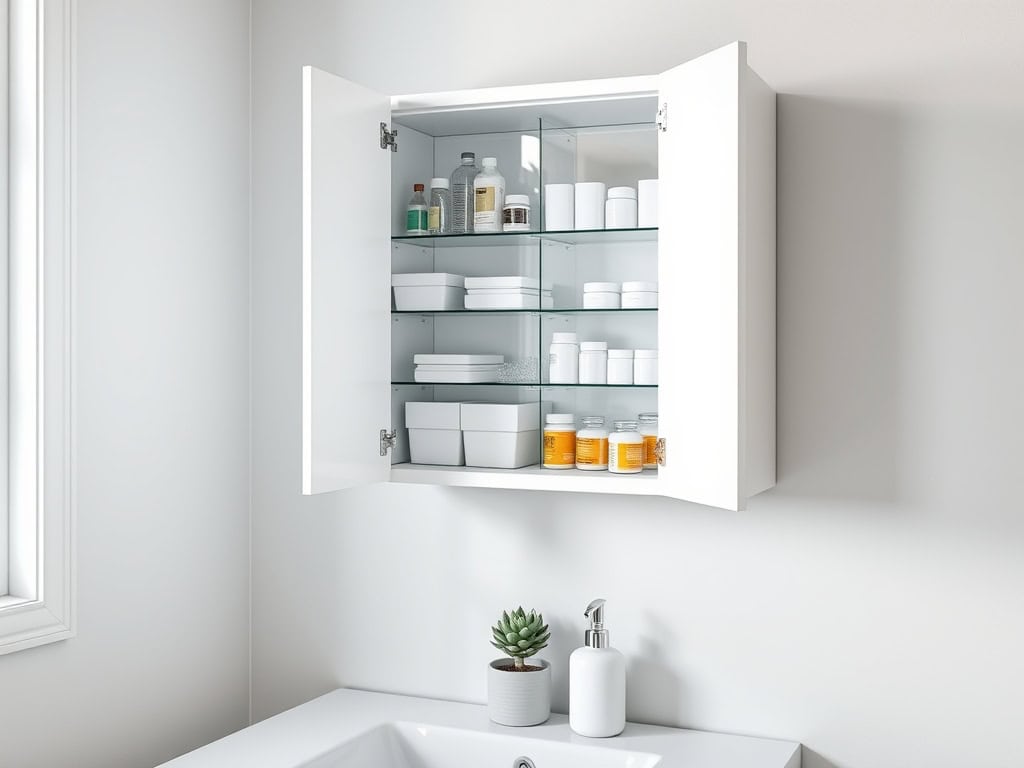You’re about to discover nine practical ways to transform your messy medicine cabinet into an organized, safe haven for all your family’s medications. As someone who once spent 20 minutes searching for children’s Tylenol at 2 AM (not fun!), I’ve learned that proper storage isn’t just about neatness – it’s about peace of mind and safety. From simple clear bins to clever rotating systems, these solutions will help you create a storage system that works for your space and lifestyle. Let’s start making your medicine storage smarter!
Clear Bins and Labels for Medication Categories
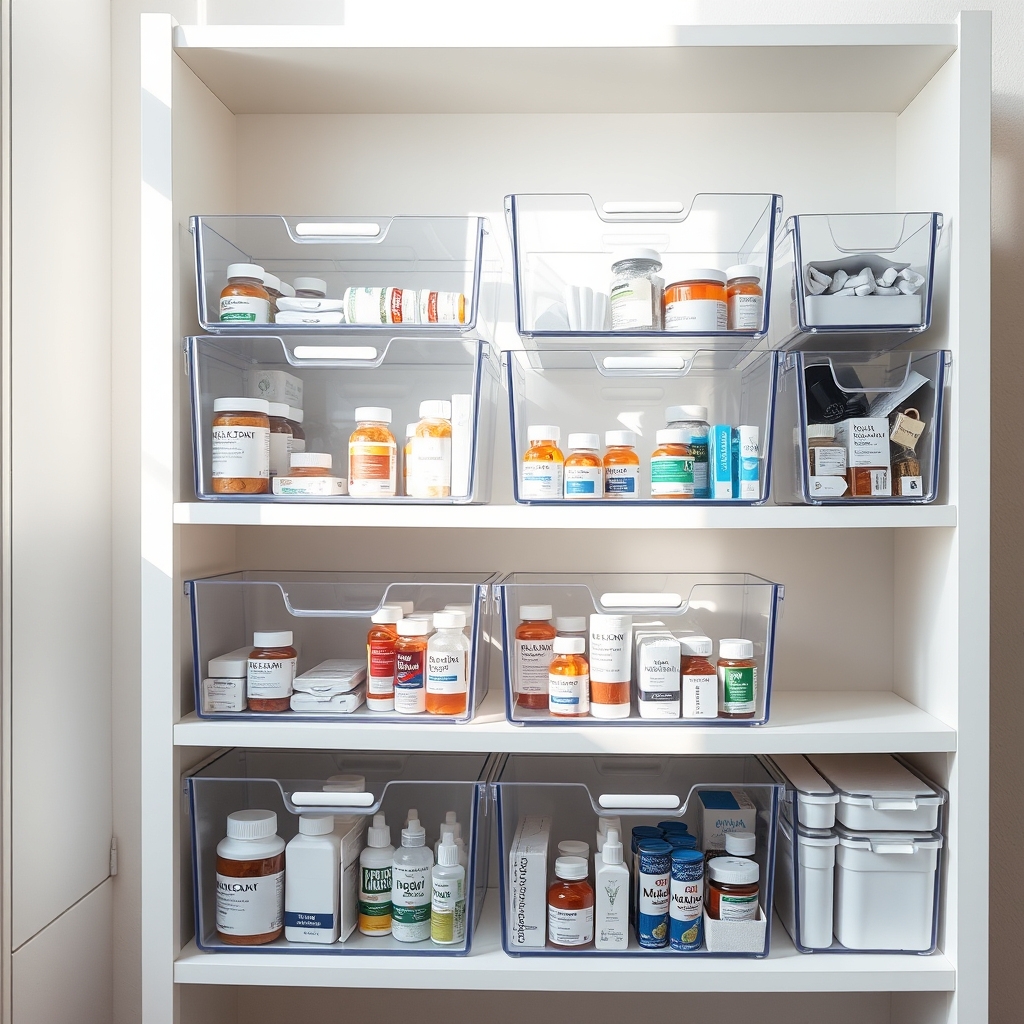
Organizing medications in clear bins with proper labels is crucial for maintaining a safe and efficient home medicine system. Proper organization can prevent medication errors, make it easier to find items quickly during emergencies, and ensure that expired medications are identified and disposed of appropriately.
Clear storage solutions combined with a logical categorization system transform a cluttered medicine cabinet into a well-organized, accessible resource. This system not only promotes safety but also helps track inventory levels and expiration dates at a glance, reducing waste and ensuring medications are available when needed.
Required Items:
- Clear plastic storage bins (various sizes)
- Label maker or waterproof labels
- Permanent marker
- Measuring tape
- Small drawer organizers or dividers
- Storage cabinet or dedicated shelf space
- Medication inventory sheet
- Small baskets for loose items
- Ziplock bags for backup storage
The organization process starts with sorting medications into distinct categories: daily prescriptions, over-the-counter medications, first aid supplies, and seasonal medications.
Once sorted, select appropriately sized clear bins for each category, ensuring they fit your storage space. Label each bin clearly with its contents and any special instructions (such as “Keep Refrigerated” or “Adult Medications Only”).
Within each primary bin, use smaller containers or dividers to separate individual items further. For example, the over-the-counter bin might have separate sections for pain relievers, cold medicines, and digestive aids. Position frequently used items at the front of bins and ensure labels are visible from multiple angles.
Additional Tips: Implement a quarterly review system to check expiration dates and reorganize as needed. Keep a master inventory list inside the cabinet door, noting medication names, quantities, and expiration dates.
Consider using color-coded labels for different family members or medication types, and always store medications in their original containers within the organizing bins. Place emergency medications in easily accessible locations, and maintain a separate, clearly marked bin for items requiring special storage conditions.
Rotating Storage System for Expiration Dates

Properly managing medication expiration dates is crucial for maintaining both the effectiveness of medicines and the safety of household members. Expired medications can lose potency, become ineffective, or even harmful, making it essential to have a system that allows you to track and rotate medicines before they expire.
A well-organized rotation system prevents waste, ensures you always have effective medications on hand, and helps maintain a clear inventory of your medicine supply. This organized approach also makes it easier to identify which medications need replacement and when to dispose of expired items properly.
Required Items:
- Clear storage containers or bins
- Label maker or permanent marker
- Small index cards
- Plastic dividers
- Monthly calendar or tracking sheet
- Clear plastic bags
- Storage basket for soon-to-expire items
Sort all medications by their expiration dates and create distinct zones within your storage area. Place items expiring within three months in an easily accessible “use first” zone. Arrange remaining medications in chronological order by expiration date, with the earliest dates at the front.
Use clear containers with labeled dividers to separate medications by month or quarter, making it simple to identify which items need attention soon. When adding new medications, always place them behind existing ones with the same name to ensure proper FIFO (First In, First Out) rotation.
Review your storage system monthly, moving items approaching expiration to the “use first” zone. Maintain a simple tracking sheet listing medication names, quantities, and expiration dates, updating it whenever you add or remove items.
Additional Tips: Consider using color-coded labels for different expiration quarters to make visual identification easier. Set calendar reminders for quarterly reviews of your medication inventory. Keep a separate list of regularly used medications and their typical shelf life to help with replacement planning.
Always check expiration dates when purchasing new medications to ensure maximum usage time, and consider requesting medications with the latest possible expiration dates from your pharmacy.
Cabinet Door Organizers and Hooks
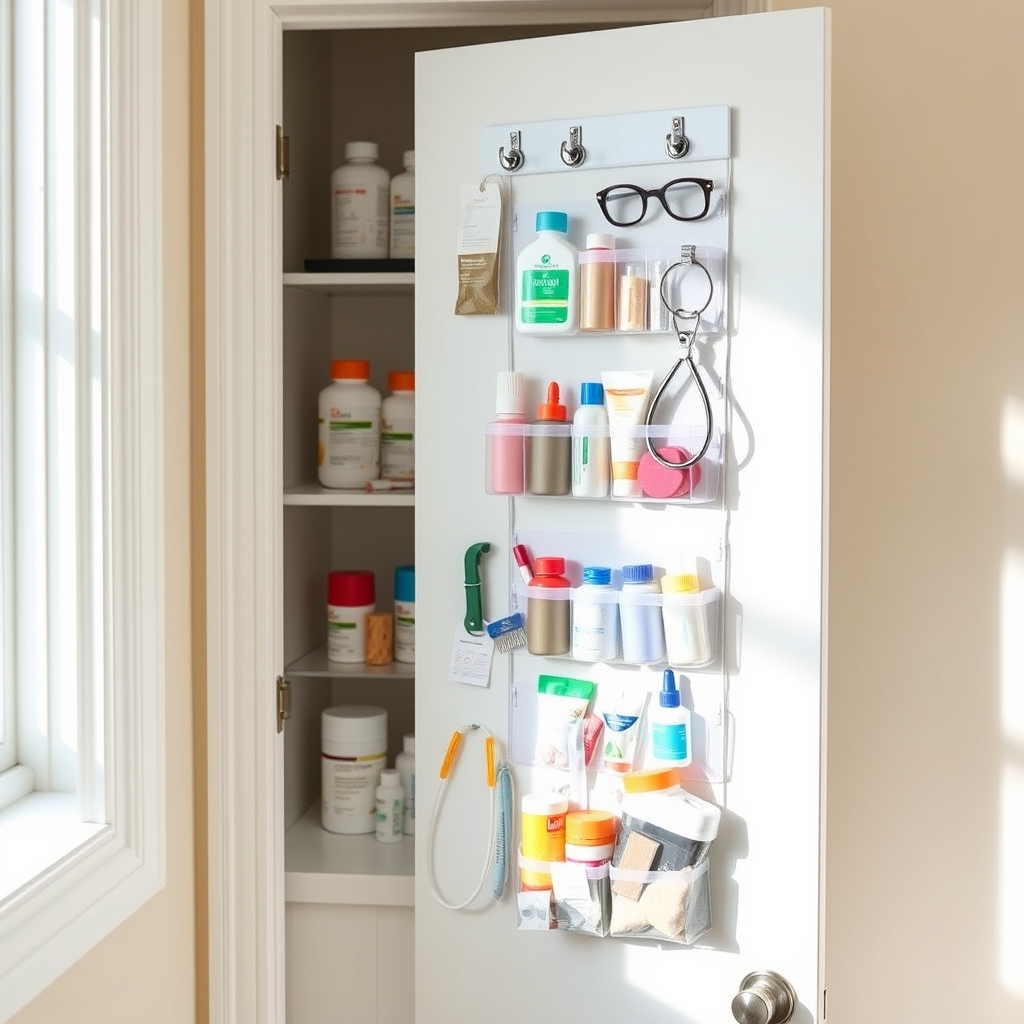
Organizing medicines on cabinet doors maximizes vertical space while keeping essential items easily accessible. This often-overlooked storage area can transform a cluttered medicine cabinet into an efficient, well-organized system that allows quick identification of medications and first-aid supplies.
Cabinet door organization is particularly valuable for families with children, as it enables parents to store medicines at a higher, safer level while keeping frequently used items within adult reach. This system also helps maintain medication safety by separating different types of medicines and keeping them visible and properly stored.
Required Items:
- Over-the-door organizers
- Adhesive hooks
- Clear plastic pouches
- Label maker
- Measuring tape
- Mounting hardware
- Small bins or baskets
- Command strips
- Storage containers with dividers
- Childproof locks
Install over-the-door organizers by measuring the cabinet door’s width and height to ensure proper fit. Mount the organizer using provided hardware or command strips, ensuring it doesn’t interfere with door closure.
Create designated zones within the organizer: daily medications at eye level, first-aid supplies in the middle, and less frequently used items at the bottom. Use clear pouches or small containers within each pocket for better organization.
For additional storage, mount adhesive hooks on the door’s interior to hang items like oral syringes or small medical devices. Install childproof locks if needed, and use a label maker to clearly mark each section with contents and expiration dates.
Group similar items together, such as pain relievers, cold medicines, and bandages, maintaining a logical flow of organization. Place frequently accessed items at eye level and ensure all storage solutions are securely fastened to prevent shifting when opening and closing the cabinet door.
Regularly review contents, remove expired medications, and adjust the organization system as needed to accommodate changing medical needs. Consider using moisture-resistant materials to protect medications from bathroom humidity.
Temperature-Safe Storage Solutions
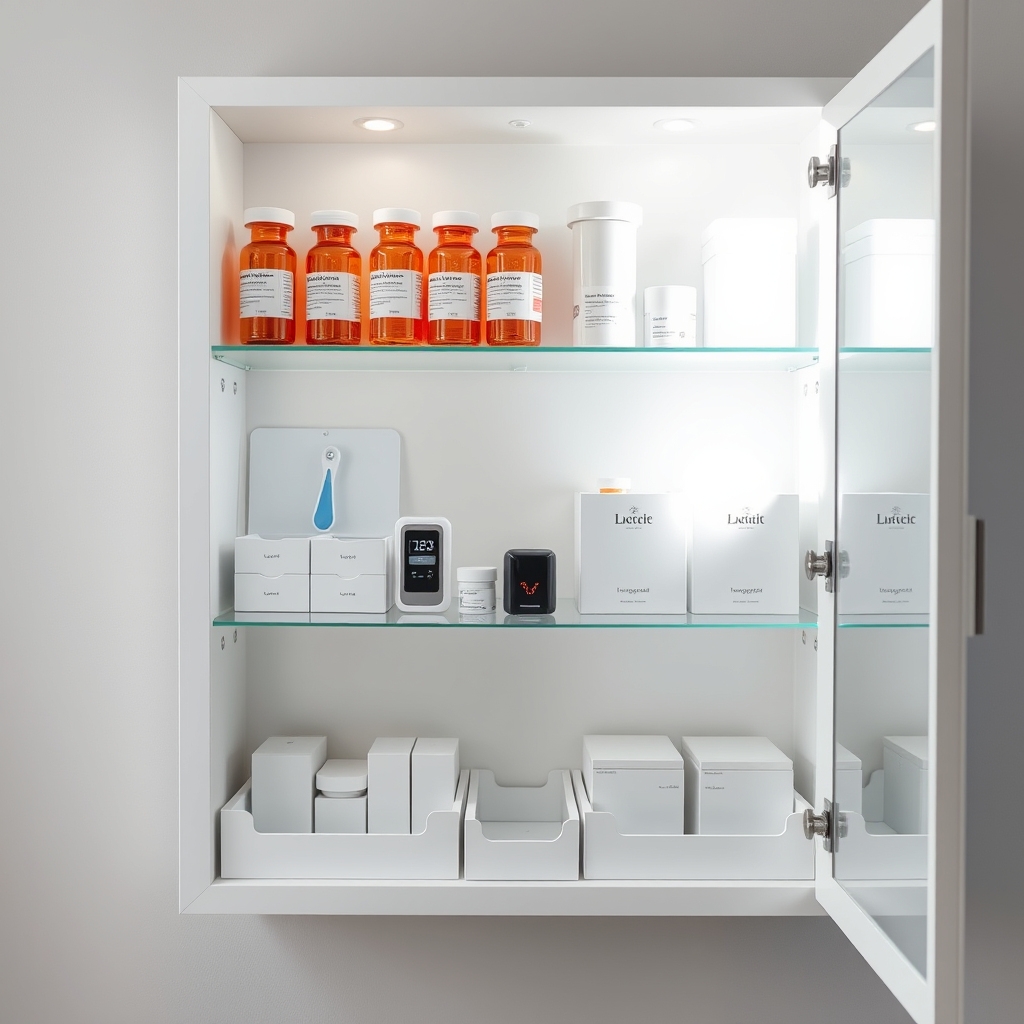
Proper temperature control for medication storage is crucial for maintaining the effectiveness and safety of both prescription and over-the-counter medicines. Most medications require storage between 68-77°F (20-25°C), and exposure to extreme temperatures can compromise their potency or even make them harmful.
Creating a well-organized, temperature-controlled storage system helps protect your family’s health and ensures medications remain effective throughout their shelf life. The organization of temperature-safe storage goes beyond simply finding a cool, dry place. It involves creating a systematic approach that considers factors like humidity control, light exposure, and temperature consistency while maintaining easy access to medicines when needed.
A properly organized system also helps track expiration dates and prevents medication mix-ups.
Required Items:
- Medicine cabinet or lockable storage container
- Thermometer
- Moisture-absorbing packets
- Label maker
- Clear storage bins
- Drawer dividers
- Medication inventory sheet
- Airtight containers
- Light-blocking containers
- Refrigerator thermometer (if storing refrigerated medications)
Begin by selecting a location away from heat sources, direct sunlight, and areas prone to temperature fluctuations like bathrooms or kitchen cabinets. Install a thermometer to monitor the storage area’s temperature consistently.
Sort medications into categories based on their specific temperature requirements, placing them in appropriate containers. Use airtight, light-blocking containers for light-sensitive medications, and implement clear bins with dividers for different categories. Label each container clearly with contents and storage requirements.
For medications requiring refrigeration, designate a specific area in your refrigerator, using a separate thermometer to ensure proper temperature maintenance. Create an inventory system that tracks location, expiration dates, and special storage requirements for each medication.
Consider using moisture-absorbing packets in storage containers to maintain optimal humidity levels.
Additional Tips: Monitor temperature readings regularly and adjust storage locations seasonally if needed. Keep a backup system during power outages, such as a cooler with ice packs for temperature-sensitive medications.
Review your storage system quarterly to ensure all medications are properly stored and organized, removing expired items and updating your inventory accordingly. Consider installing a small, dedicated medication refrigerator if you have multiple temperature-sensitive medications.
Child-Proof Container Systems
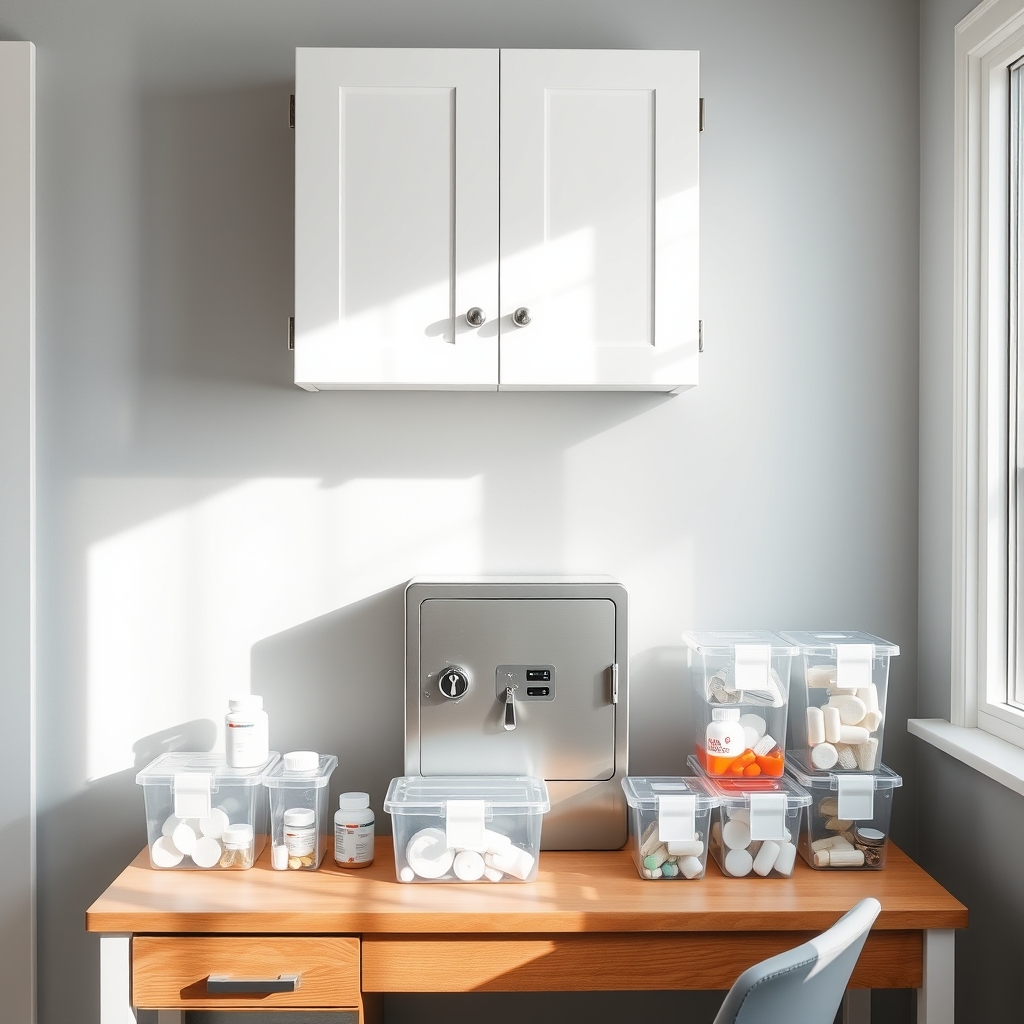
Properly organizing child-proof medicine storage is crucial for maintaining both safety and accessibility in your home. With medication-related accidents being a leading cause of emergency room visits for young children, implementing a robust child-proof storage system isn’t just about organization – it’s about creating a secure environment for your entire family.
A well-organized child-proof medicine storage system allows adults to quickly access needed medications while maintaining multiple layers of safety for children. The key is combining proper locking mechanisms with systematic organization, ensuring that medicines remain both secure and easily identifiable for adult use.
Required Items:
- Child-resistant storage containers
- Lock boxes with combination or key
- Medicine cabinet with childproof lock
- Label maker
- Clear storage bins with locking lids
- Drawer dividers
- Rubber grips for tight lids
- Temperature monitoring device
- Emergency contact list
- Medication inventory sheet
Select a high location, preferably 5 feet or higher from the ground, and install a lockable medicine cabinet or dedicated storage area. Sort medications into categories (prescription, over-the-counter, first aid) and place them in separate child-resistant containers. Each container should have both a child-resistant closure and an additional locking mechanism.
Install cabinet locks that require either a combination or key for access, ensuring all medications have two layers of protection. Create a labeling system that clearly identifies contents while maintaining child safety – avoid bright colors or pictures that might attract children’s attention. Store containers in a cool, dry place away from direct sunlight and bathroom humidity.
Implement a regular inventory system to track expiration dates and medication quantities, keeping all documentation in a separate, secure location.
Success Tips: Regularly test all locks and child-resistant mechanisms to ensure proper function. Establish a routine of double-checking that all containers are properly sealed and locked after each use.
Keep emergency numbers visible near storage areas for quick access, but maintain all medication information in a separate, secure location away from children’s reach. Consider installing a temperature monitor if storing temperature-sensitive medications, and create a backup plan for power outages or emergencies that might affect storage conditions.
Daily Medication Tracking Stations
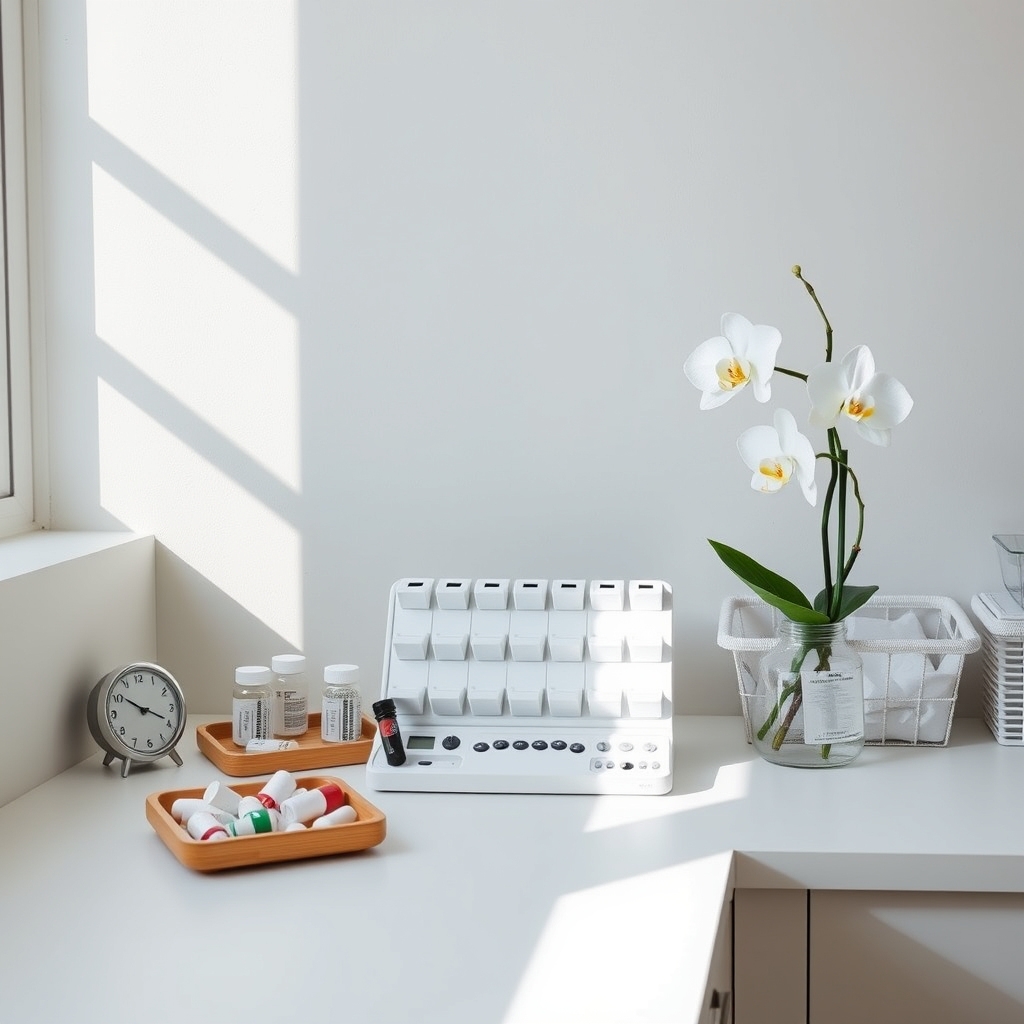
Organizing a dedicated medication tracking station is crucial for maintaining consistent medication schedules and preventing missed doses. A well-organized system reduces stress, helps avoid medication errors, and ensures that all household members can easily track their daily medications.
Creating an efficient medication tracking station not only promotes better health management but also provides peace of mind for caregivers and family members. When medications are properly organized and tracked, it becomes easier to notice when supplies are running low and maintain accurate records for medical appointments.
Required Items:
- 7-day pill organizer
- Label maker
- Small whiteboard or medication tracking calendar
- Timer or alarm clock
- Storage container or basket
- Clear storage bins
- Medication list template
- Writing supplies
- Small notebook
- Sticky notes
Select a central, easily accessible location for your medication tracking station, preferably in a cool, dry area away from direct sunlight. Start by sorting medications into clearly labeled containers based on timing (morning, afternoon, evening) and user. Fill weekly pill organizers every Sunday evening, double-checking all medications against your written list.
Create a simple tracking sheet that includes medication names, dosages, and times, then mount it nearby for quick reference. Place frequently used items within easy reach and store backup supplies in labeled bins below.
Consider adding a backup power source for any electronic components, especially if medication timing is critical. Keep a small notepad nearby to record any changes, side effects, or questions for healthcare providers. Maintain a simple inventory system to track medication quantities and refill dates.
Additional Tips: Implement a buddy system for double-checking medication organization, especially when setting up weekly doses. Use color coding for different family members or medication times to prevent confusion. Keep emergency contact information and pharmacy details posted visibly near the station.
Review and update your system monthly to ensure it continues to meet your needs effectively.
Emergency Kit Organization
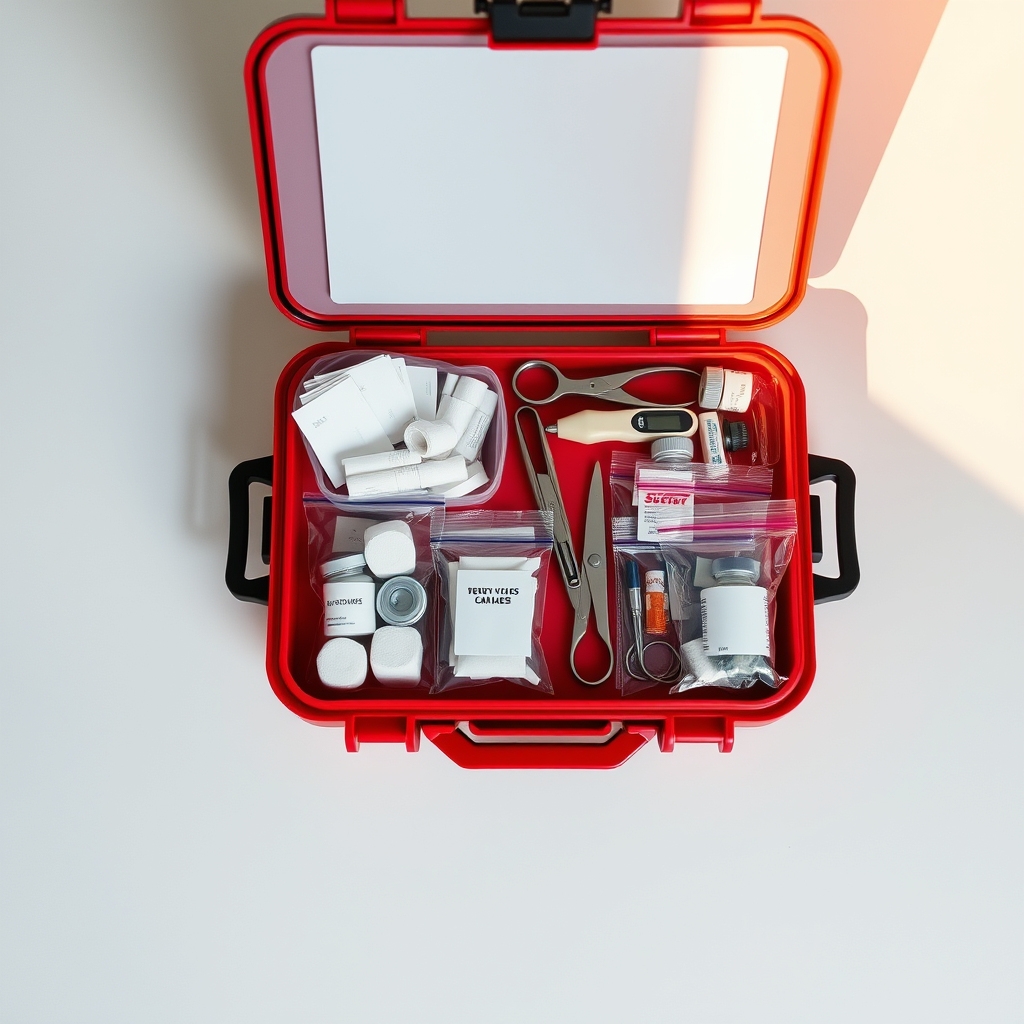
Having a well-organized emergency medical kit can make all the difference during unexpected situations or accidents. Quick access to necessary supplies can help manage minor emergencies effectively and potentially prevent more serious complications until professional medical help arrives.
An organized emergency kit ensures that all family members can locate essential items quickly and know exactly what resources are available. This organization system also makes it easier to track expiration dates, maintain supply levels, and replace items as needed.
Required Items:
- Large waterproof container or bag
- Clear plastic containers or zip-lock bags
- Label maker or waterproof labels
- Emergency contact card
- First aid manual
- Inventory checklist
- Dividers or compartment organizers
- Permanent marker
- Small flashlight
- Digital thermometer
Begin by selecting a waterproof container that’s easily identifiable and accessible. Sort all medical supplies into categories: bandages/wound care, medications, tools (scissors, tweezers), and emergency equipment.
Place each category into separate clear containers or zip-lock bags, clearly labeled with contents and expiration dates. Position frequently used items near the top of the kit for quick access.
Create a detailed inventory list and attach it inside the kit’s lid. Include quantities, expiration dates, and the location of each item within the kit. Place emergency contact numbers, including poison control, local emergency services, and family doctors, in a visible location inside the kit.
Organize medications alphabetically and ensure all prescription medications are clearly marked with the name of the family member they belong to.
To maintain the effectiveness of your emergency kit organization, schedule quarterly reviews to check expiration dates, replace used items, and update emergency contact information.
Store the kit in a cool, dry place away from direct sunlight and ensure all family members know its location and basic contents. Consider creating a smaller duplicate kit for your car or workplace to ensure emergency supplies are always within reach.
Small-Space Storage Optimization
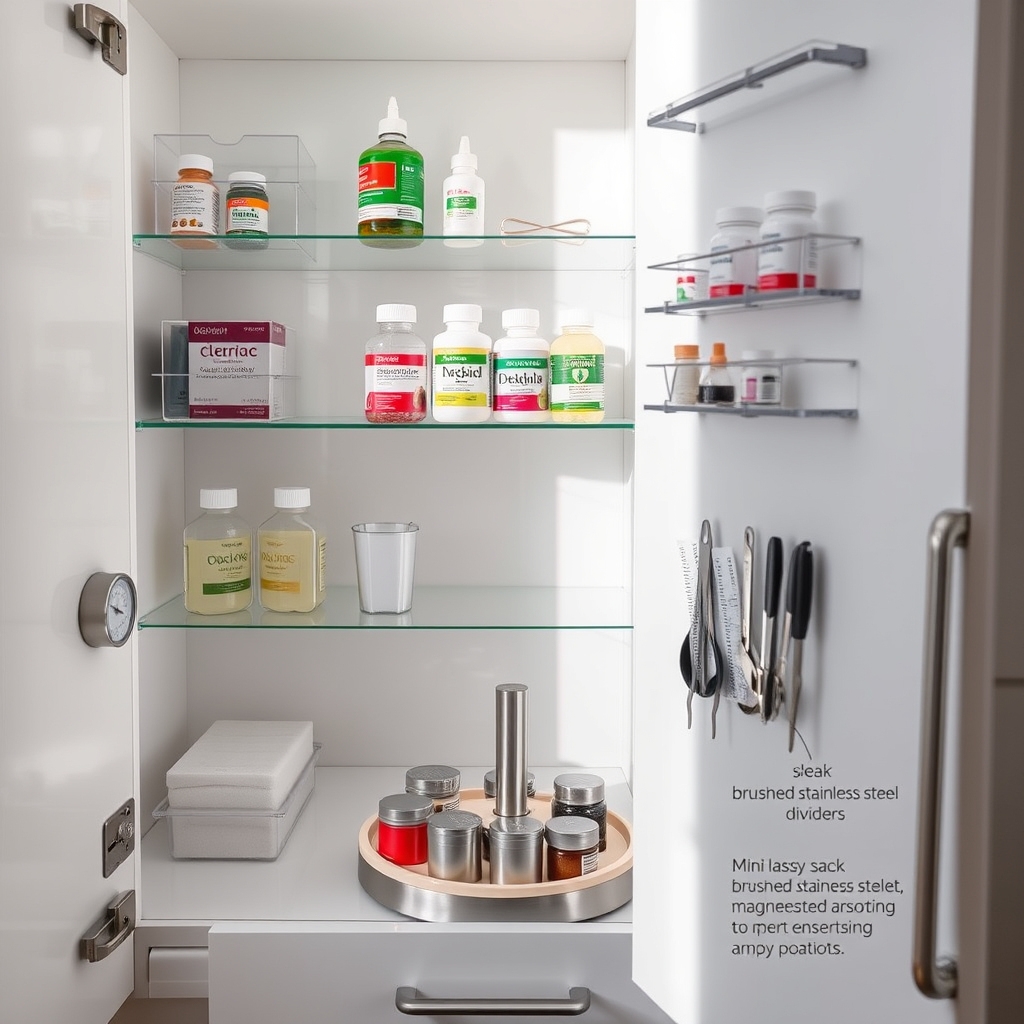
Organizing medications in limited space isn’t just about fitting everything in – it’s about creating a system that ensures safety and accessibility while maximizing every available inch. Proper organization can mean the difference between quickly finding needed medicine during an emergency and frantically searching through cluttered cabinets.
In small living spaces, creative storage solutions become essential for maintaining an organized medicine collection while ensuring medications remain secure and properly stored. Strategic use of vertical space, door-mounted organizers, and multi-functional storage containers can transform a cramped area into an efficient medical storage zone.
Required Items:
- Clear plastic containers with lids
- Label maker or waterproof labels
- Over-the-door organizer
- Small lazy Susan
- Drawer dividers
- Stackable bins
- Command hooks
- Small baskets
- Temperature monitor
- Moisture-absorbing packets
Start by sorting medications into categories: daily medications, first aid supplies, seasonal medications, and emergency items. Install an over-the-door organizer on the inside of a cabinet door or closet to utilize vertical space. Place frequently used items at eye level and arrange less-used items in higher or lower pockets.
Use clear containers with secure lids to group similar items together, ensuring all containers are clearly labeled with contents and expiration dates. For drawer organization, implement dividers to create designated spaces for different medication types. Position a lazy Susan in deep cabinets to provide easy access to items stored in the back.
Stack similar-sized containers to maximize vertical space, but maintain easy access to all items. Consider using magnetic strips or command hooks on the inside of cabinet doors for items like scissors, tweezers, or small first aid supplies.
Additional Tips:
Keep a detailed inventory list posted inside the cabinet door to track supplies and expiration dates. Store medications requiring special temperature conditions separately, and use moisture-absorbing packets in containers to protect medicine from humidity.
Review and reorganize the storage system every three months to maintain efficiency and remove expired items.
Humidity-Resistant Storage Methods
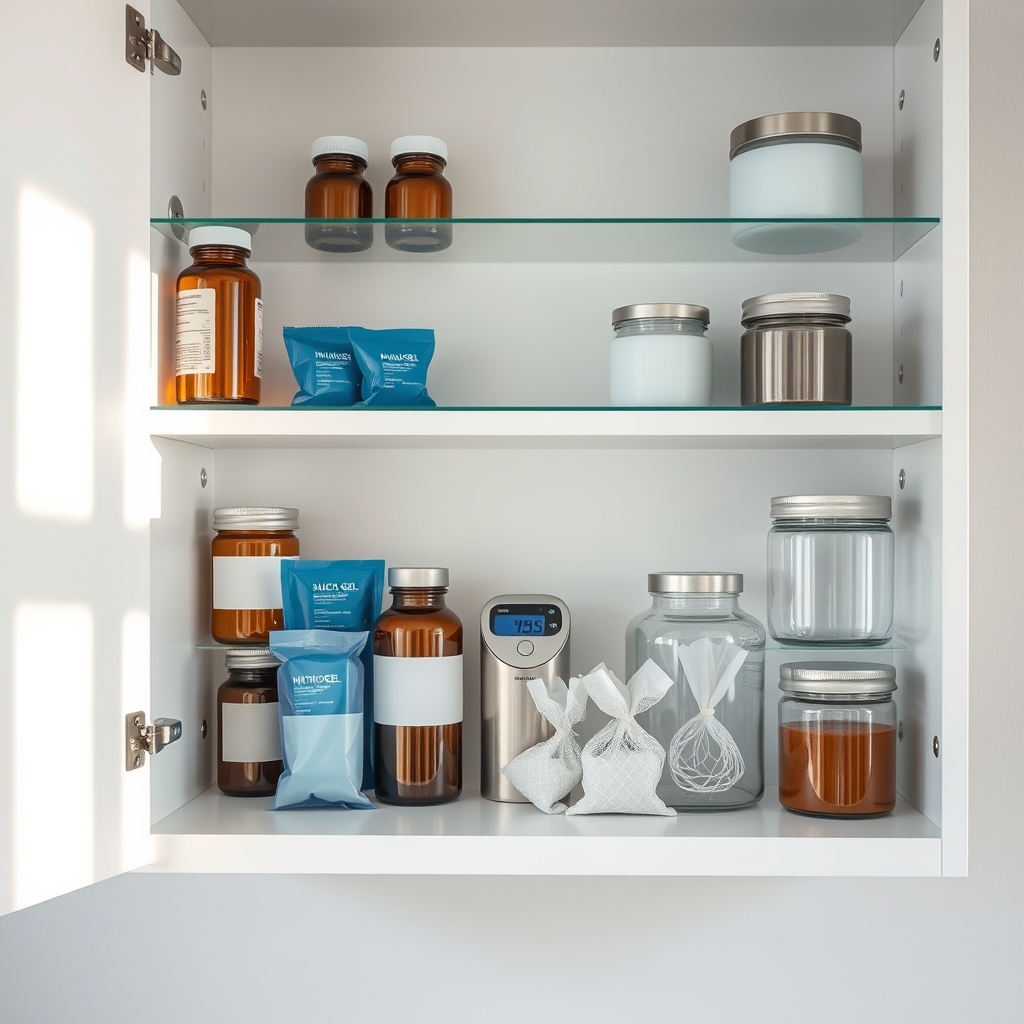
Proper humidity control in medicine storage is crucial for maintaining the effectiveness and safety of medications. High humidity levels can degrade pharmaceutical compounds, leading to reduced potency and potentially harmful chemical changes in certain medications. Many common medications are particularly sensitive to moisture, making humidity-resistant storage a fundamental aspect of home medicine organization.
Creating a humidity-resistant medicine storage system not only protects your medications but also helps prevent costly waste from damaged products. When medications are exposed to excessive moisture, they can become clumped, discolored, or develop mold, rendering them unsafe for consumption. A well-planned humidity-resistant storage solution ensures your medicines remain stable and effective throughout their intended shelf life.
Required Items:
- Silica gel packets
- Airtight storage containers
- Moisture-proof medicine bottles
- Humidity indicator cards
- Storage cabinet or box with rubber seals
- Desiccant containers
- Labels and markers
- Plastic storage bags with zip-seals
- Moisture-absorbing products
- Digital hygrometer
To establish effective humidity-resistant storage, start by selecting a location away from bathrooms, kitchens, or other high-moisture areas. Install a storage cabinet or box with rubber seals at eye level in a cool, dry space. Place silica gel packets or desiccant containers strategically throughout the storage unit to absorb excess moisture.
Transfer medications from original containers to moisture-proof bottles if the original packaging isn’t adequately protected. Monitor humidity levels regularly using a digital hygrometer and humidity indicator cards. Maintain optimal humidity levels between 35-45% by adding or replacing moisture-absorbing products as needed.
Organize medications in sealed plastic bags with clear labels, grouping similar items together. Place frequently used items in easily accessible locations while ensuring all containers remain tightly sealed after each use.
Additional Success Tips: Check humidity-control products monthly and replace them when saturated. Keep a log of when desiccants and silica gel packets were last changed. During humid seasons, consider using a small dehumidifier near the storage area.
Never store medicines in their original paper or cardboard packaging without additional moisture protection. Regularly inspect stored medications for any signs of moisture damage, such as dissolving tablets, sticking capsules, or unusual odors.

